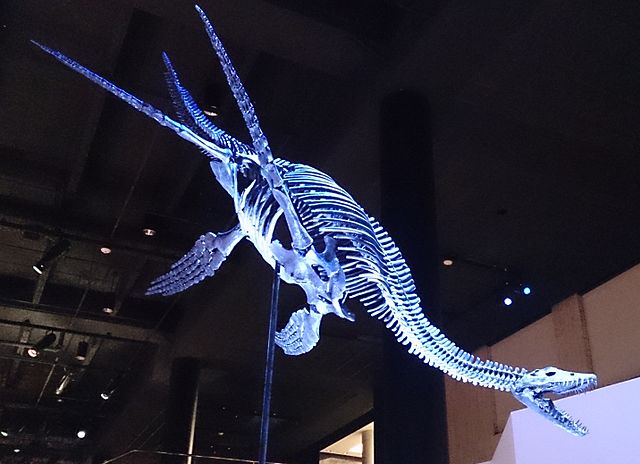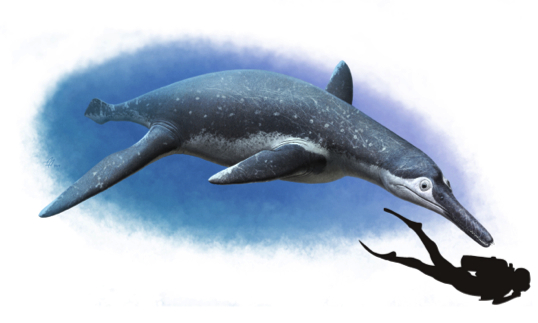A recent report from researchers at the University of Liege in Belgium has given us a new species of pliosaur: Meet Luskhan itilensis (say LOO-skahn ih-tih-LEHN-sis). It was discovered in 2002 on the banks of the Volga River in Russia. Years of processing the fossil and research have confirmed that it is unlike any pliosaur discovered.
Don't forget the marine reptiles!
The Mesozoic Era, or the Age of Dinosaurs, lasted about 179 million years. We all know that the land was full of giant reptiles during this time. But it's easy to forget that the seas were full of just as much (if not far more) stunning collections of species. Bony fish, primitive sharks, amazing ancestors of squid, cuttlefish, crabs, and turtles. The coolest of all, though, were the marine reptiles.
These large, air-breathing animals were perfectly adapted to life in the oceans. Ichthyosaurs were like swift dolphins with long jaws for snapping up fish.
Plesiosaurs looked like swimming sauropods—wide, heavy bodies with four flippers and an extremely long neck to whip around in search of food.

A skeleton of a plesiosaur, showing its extra long neck. (Wikimedia Commons)
But it was a relative of the plesiosaurs that was an apex, or top, predator of its time. The pliosaur.

An illustration of liopleurodon, a pliosaur species. (Wikimedia Commons)
They had thicker, shorter necks and larger, more powerful jaws. And they were fast, chasing down prey with the intensity of a shark.
And now, thanks to this Russian discovery, we have this brand new pliosaur species to get excited about. If Luskhan itilensis is too much of a mouthful, you can just call it "Master Spirit of the Volga River", which is what its name means. Cool! Let's check it out!
A busload of trouble
This dangerous creature was about the size of a bus. It had a head that was around 1.5 metres (5 feet). That's almost as long as an adult is tall. Some pliosaurs had a snout that was fairly thick, like that of an American alligator. But Luskhan itilensis had one that was thinner than many of its relatives. This made it more similar to current reptiles like the gharial, a fish-eating crocodile from India.
Despite these thinner jaws, it still likely had a very powerful bite (so if you're time travelling any time soon, we'd still recommend keeping your distance!). According to lead researcher Valentin Fischer (and bear with us here), its thin jaw "is the most striking feature, as it suggests that pliosaurs colonized a much wider range of ecological niches than previously assumed."
In other words? It hunted slightly different prey than many of its cousins. Why does that matter? Well, paleontologists get especially excited when they discover new proof of small differences between similar animal species. It's a reminder that life during the Mesozoic was likely just as full of stunning variety as modern Earth is. And that there are probably so many more species yet to be discovered!
Welcome back, Master Spirit!
 An artist's recreation of the new pliosaur species. The diver next to it shows a comparison of how big it was compared to a full-grown man. (Andrey Atuchin/University de Liege)
An artist's recreation of the new pliosaur species. The diver next to it shows a comparison of how big it was compared to a full-grown man. (Andrey Atuchin/University de Liege)










cool! welcome to discovery, master spirit of the volga river!!??
The differences between the plesiosaurs and the pliosaurs are:
– The plesiosaur has a long neck and the pliosaurs has a short neck.
– the plesiosaur has a small head and the pliosaurs has a long head.
– the plesiosaur size of a van and a pliosaurs is a size of a bus.
the name means master spirit.
The plesiosaur eat animals.